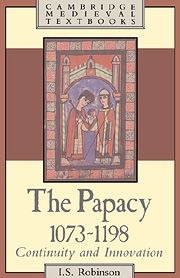Book contents
- Frontmatter
- Contents
- Preface
- List of abbreviations
- BIBLIOGRAPHICAL NOTE
- PART I THE PAPAL GOVERNMENT
- 1 Rome and the Patrimony of St Peter
- 2 The college of cardinals
- 3 Papal councils
- 4 Papal legates
- 5 Papal justice and papal legislation
- 6 The papacy, the religious orders and the episcopate
- 7 Papal finance
- PART II THE PAPACY AND THE SECULAR POWERS
- Appendix A list of popes, 1073–1198
- Index
6 - The papacy, the religious orders and the episcopate
Published online by Cambridge University Press: 05 June 2012
- Frontmatter
- Contents
- Preface
- List of abbreviations
- BIBLIOGRAPHICAL NOTE
- PART I THE PAPAL GOVERNMENT
- 1 Rome and the Patrimony of St Peter
- 2 The college of cardinals
- 3 Papal councils
- 4 Papal legates
- 5 Papal justice and papal legislation
- 6 The papacy, the religious orders and the episcopate
- 7 Papal finance
- PART II THE PAPACY AND THE SECULAR POWERS
- Appendix A list of popes, 1073–1198
- Index
Summary
In a letter of 1081 Gregory VII informed the faithful that the founders of the Poitevin monastery of St Peter in Maskarans had surrendered the monastery to the pope and that consequently he had ‘received it into the jurisdiction and defence of the apostolic see’. ‘Therefore we command by apostolic authority that no one shall presume henceforward to trouble the aforesaid place, fortified by apostolic defence, but that it shall remain in peace and free from any disturbance under the protection of St Peter, to whose jurisdiction it belongs.’ During the late eleventh and twelfth centuries religious houses sought St Peter's protection – called variously protectio, defensio, tutela, tuitio, munimen, patrocinium – on a scale unsurpassed during the rest of the Middle Ages. In the early Middle Ages monasteries had generally looked to kings for protection; but the disintegration of the Carolingian empire in the ninth century compelled them to find stronger protectors. ‘For the dwindling protection of Charles the Bald and Charles the Fat was substituted the defensio or tuitio of the saints, but especially that of St Peter, that is, of the Roman see.’ This development began in 863, when Count Gerald of Roussillon commended to St Peter the two monasteries which he had founded on his allodial lands of Vézelay and Pothières. The most famous case of such a commendation occurred in 910, when Duke William ‘the Pious’ of Aquitaine secured for his monastery of Cluny ‘the protection of the apostles [Peter and Paul] and the defence of the Roman pontiff’.
- Type
- Chapter
- Information
- The Papacy, 1073–1198Continuity and Innovation, pp. 209 - 243Publisher: Cambridge University PressPrint publication year: 1990



